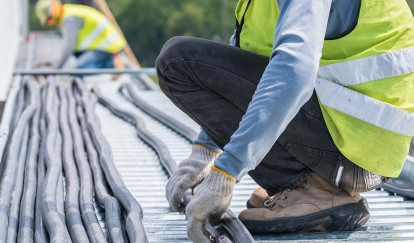
Share This Article
Construction workers face many hazards when they go to work on construction sites each morning – there are trip hazards, risks of equipment failure and potential falls from dangerous heights. In addition, with multiple workers using a variety of electric power tools, potential contact with buried and overhead power lines, new wiring being installed, and the combination of exposed wiring and ever-changing weather conditions, the risk of electrocution and electric shock is high on construction sites. In fact, OSHA (the Occupational Safety & Health Administration) states that electrocution is one of the four most common perils on construction sites.
Construction work is inherently dangerous—the Bureau of Labor Statistics lists it as one of the 10 most dangerous jobs in the United States. In the construction industry, electrocution hazards are responsible for 411 deaths annually, on average. That's about 9% of all construction fatalities. There are also five to 10 electric shocks suffered from accidental contact with an electrical circuit daily. As Richmond workers' compensation attorneys, we believe it's critical that employees know how to work around electricity safely, and that employers enforce safe work habits.
Electrical Injuries Explained
An electric shock occurs when an electric current passes through the body. An electric shock is an electrical injury from which a person recovers; electrocution is an electrical accident that causes a person's death.
The severity of an electrical injury depends on three things:
- What path the electric current takes through the body
- The amount of current that flows through the body
- How long the body is exposed to the electric current
Note that even low-voltage shocks are extremely dangerous. Any type of electric shock can result in external burns and blistering of the skin in addition to injury of internal organs. Cases of severe electric shock can result in death if medical intervention isn't administered quickly.
What to Do After an Electrical Injury at Work
If you suffer an electric shock injury at your workplace or while you're on a job site―whether it's a construction site or other job location―here's what to do:
- Seek medical attention immediately. Document your first medical visit and any additional visits by recording the doctors' names who treated you, any treatment recommendations they provided and medications you received.
- Notify your manager or supervisor as soon as possible after the accident, preferably in writing (and be sure to keep a copy). If you notify your supervisor verbally, try to do so with a coworker present. Documentation of what is conveyed in this discussion can become important later in your case.
- Write down the contact information of anyone who witnessed your injury or accident, including coworkers or passersby.
- Document the site, location and conditions under which your accident happened by taking photos of the area and scene where your accident occurred. Be sure to get photos from multiple angles of the location where your accident happened, in addition to the tools, equipment or machinery that was involved. The more photos you take, and the sooner after the accident you can take them, the better. If you're hospitalized, ask a coworker to take photos for you.
- Document your injuries by taking photos, both immediately after the injury and at regular intervals as you are healing.
- Collect as much evidence as possible in its exact condition at the time of the accident to back up your claim of the work injury and how it happened. This includes preserving the clothes and shoes you were wearing―don't wash them―and any tools, equipment or machinery that may have contributed to your accident.
If you have been injured at work or through the negligence of another individual or entity, contact us at (804) 999-9999 or or use the form below to connect with our legal team. We will fight to get you the justice you deserve.
